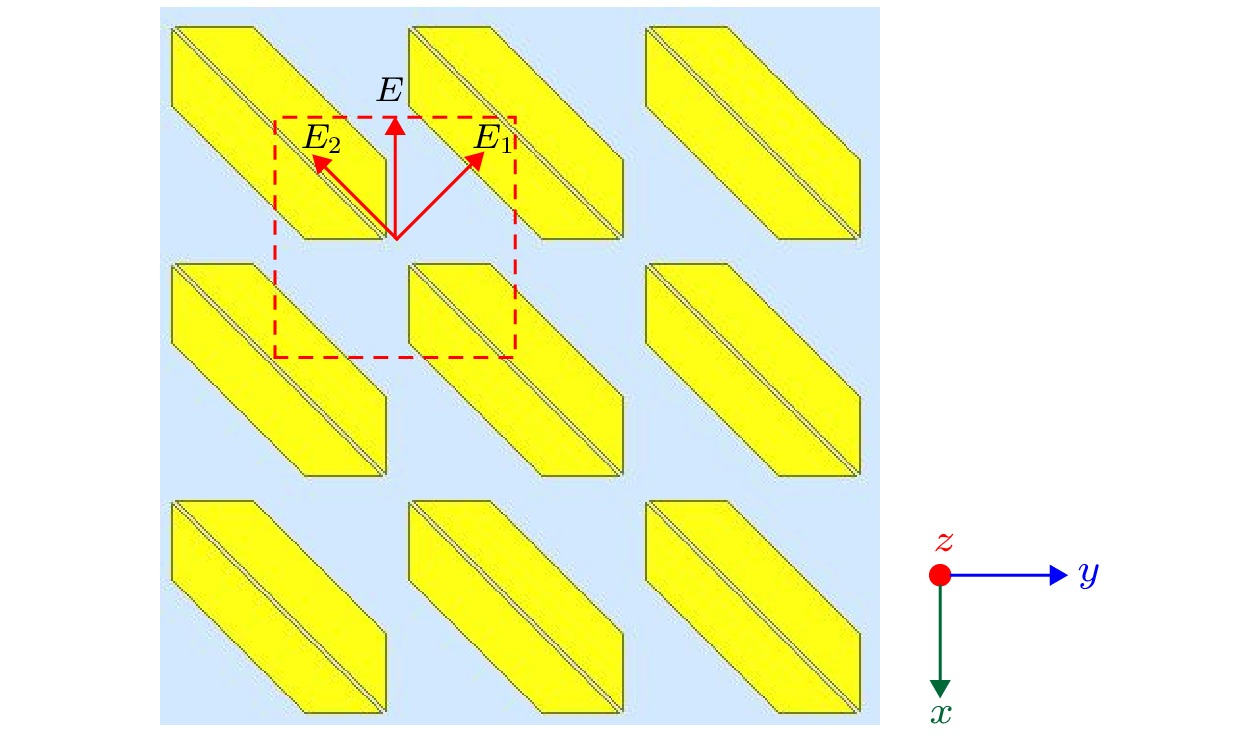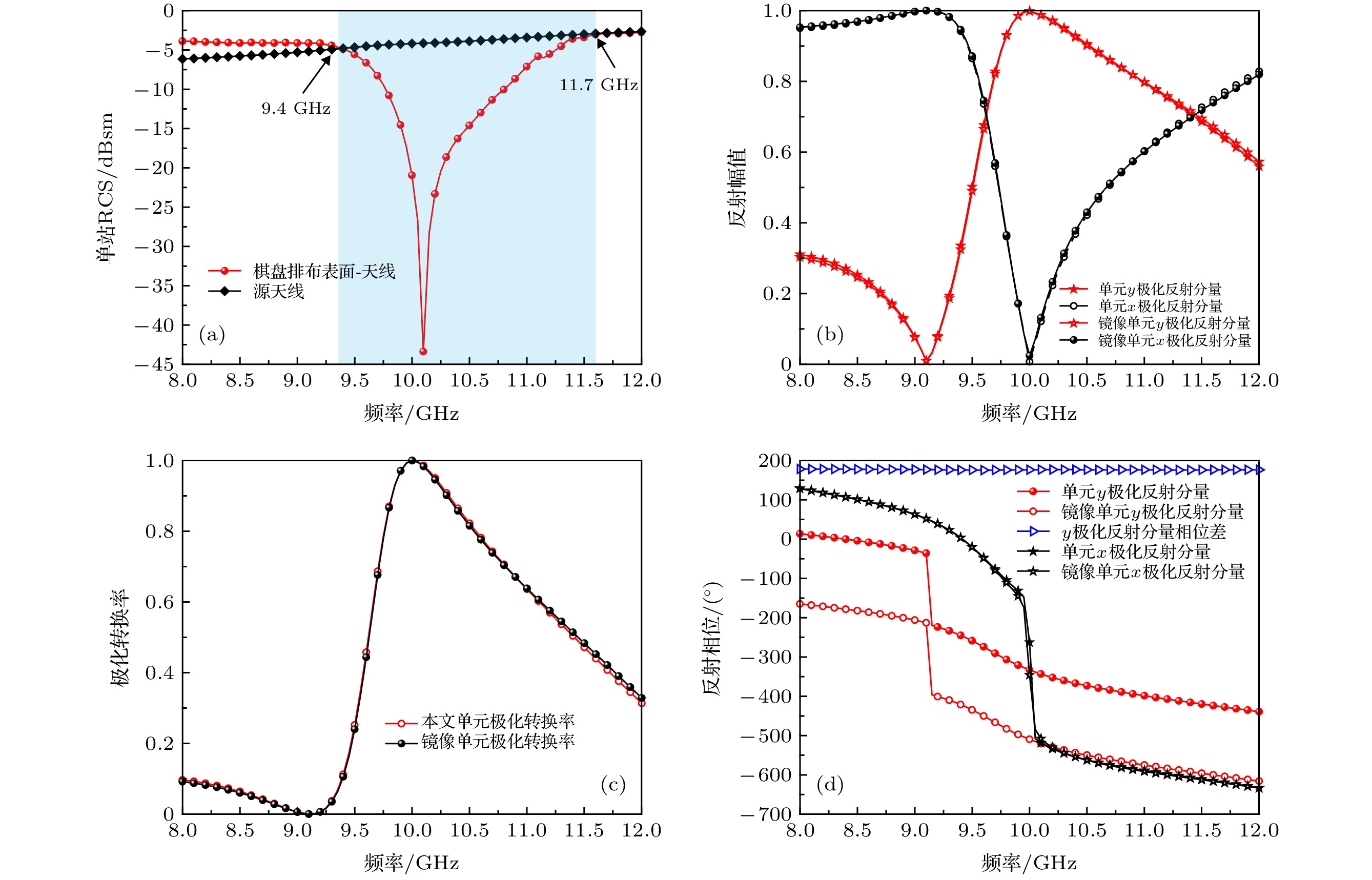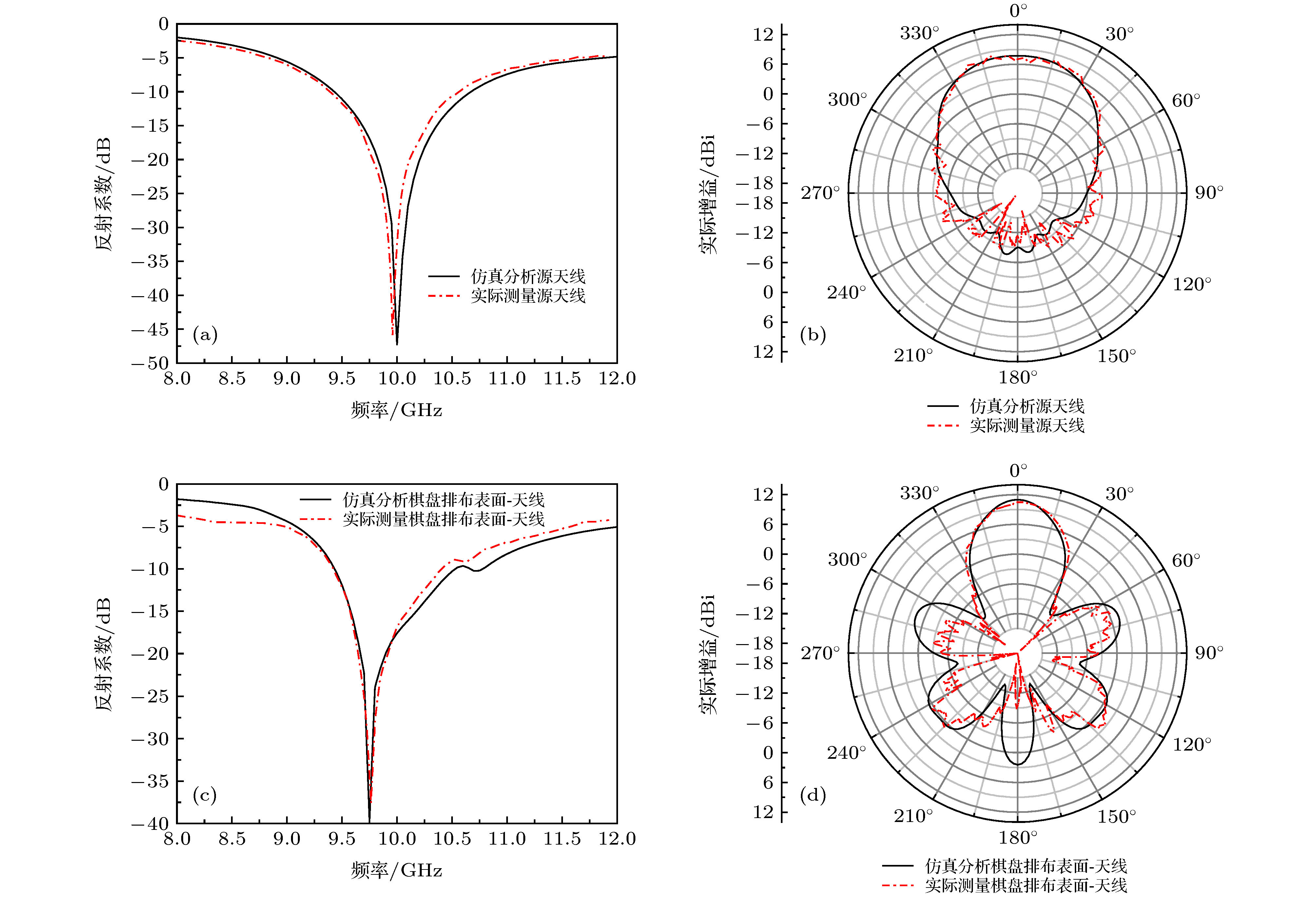-
透射型极化转换表面因其具有易于与天线共形的巨大应用优势, 受到国内外学者的广泛关注. 本文将极化栅结构与各向异性贴片结构相结合, 设计并验证了一种复合型透射极化转换单元, 将该极化转换单元组成透射超表面, 可以同时实现极化选择和透射型线-圆极化变换两种功能. 当电磁波极化方向垂直于极化栅延伸方向入射到复合型极化转换表面时, 该极化转换表面可以在9.3—10.9 GHz实现透射型线-右旋圆极化转换, 当电磁波极化方向平行于极化栅延伸方向入射时, 可以实现同极化全反射. 将该极化转换单元及其镜像单元棋盘排布后组成棋盘排布表面, 以电磁表面覆层的形式应用于带宽为9.4—10.7 GHz的线极化源微带天线, 利用圆极化的相反旋向对消特性, 组成一款新颖的线极化天线. 相比于源微带天线, 在9.5—10.5 GHz该天线的线极化纯度得到提高, 同时实现了天线的前向增益提高和带内雷达散射截面减缩, 最大减缩量达39.2 dB. 实验验证和仿真结果吻合较好, 该设计在高增益、低散射天线设计和天线辐散射性能综合调控中具有重要的参考价值.The transmission polarization conversion metasurface has been widely concerned, because it has the advantage of being easy to be conformal with the antenna. Based on the reasonable arrangement of transmission polarization conversion units, various and complex electromagnetic functions can be realized. As the electromagnetic open window on the flight platform, the antenna is the bottleneck that restricts the decrease of radar cross section (RCS) of the whole flight platform. It is difficult to simultaneously realize the normal and efficient radiation of the antenna and the decrease of the RCS of the antenna. When the designed transmission metasurface is used in the antenna design, the radiation and scattering of the antenna can be regulated comprehensively. In this paper, a composite polarization conversion metasurface is proposed and verified. The unit cell of composite polarization conversion metasurface consists of two mirror symmetrical anisotropic metal patches in the upper layer, a dielectric layer and a polarization gate in the lower layer. When the polarization direction of the incident electromagnetic wave is perpendicular to the extension direction of the polarization gate and arrives at the composite polarization conversion surface, the conversion surface can realize the conversion from transmission linear polarization to right-hand circular polarization in a frequency range from 9.3 GHz to 10.9 GHz. When the polarization direction of the incident electromagnetic wave is parallel to the extension direction of the polarization gate, co-polarized total reflection can be realized. The chessboard arrangement metasurface is composed of composite polarization conversion unit and its mirror unit. A novel linearly polarized chessboard arrangement metasurface antenna is composed of the linearly polarized source microstrip antenna with a bandwidth of 9.4–10.7 GHz and the chessboard arrangement metasurface. By using the counter rotating cancellation characteristic of circular polarization, the chessboard arrangement metasurface antenna maintains linearly polarized radiation. Comparing with the source microstrip antenna, the linear polarization purity of chessboard arrangement metasurface antenna is improved from 9.5 GHz to 10.5 GHz. At the same time, the forward gain of the chessboard arrangement antenna increases and the radar cross section decreases. The maximum reduction is 39.2 dB. To further verify the practicability of the design and analysis, the chessboard arrangement metasurface antenna sample is fabricated and measured in microwave anechoic chamber with an Agilent 5230C network analyzer. The experimental results are in good agreement with the simulation results. This study has important reference value in the design of high gain, low RCS antenna and integrated regulation radiation and scattering of antenna.
-
Keywords:
- transmission polarization convention /
- metasurface /
- antenna
[1] Challita F, Laly P, Yusuf M, Tanghe E, Joseph W, Lienard M, Gaillot D P, Degauque P 2020 IEEE Antennas Wirel. Propag. Lett. 19 297
 Google Scholar
Google Scholar
[2] Gaillot D P, Tanghe E, Joseph W, Laly P, Tran V C, Lienard M, Martens L 2015 IEEE Trans. Antennas Propag. 63 3219
 Google Scholar
Google Scholar
[3] Dimitrov K C, Lee Y, Min B W, Park J, Jeong J, Kim H J 2020 IEEE Antennas Wirel. Propag. Lett. 19 317
 Google Scholar
Google Scholar
[4] Hasani H, Silva J S, Capdevila S, Garcia-Vigueras M, Mosig, J R 2019 IEEE Trans. Antennas Propag. 67 5325
 Google Scholar
Google Scholar
[5] 韩江枫, 曹祥玉, 高军, 李思佳, 张晨 2016 65 044201
 Google Scholar
Google Scholar
Han J F, Cao X Y, Gao J, Li S J, Zhang C 2016 Acta Phys. Sin. 65 044201
 Google Scholar
Google Scholar
[6] Lin D M, Fan P Y, Hasman E, Brongersma M L 2014 Science 345 28
 Google Scholar
Google Scholar
[7] Tao Z, Wan X, Pan B C, Cui T J 2017 Appl. Phys. Lett. 110 121901
 Google Scholar
Google Scholar
[8] Binion J D, Lier E, Werner D H, Hand T H, Jiang Z H, Werner P L 2020 IEEE Trans. Antennas Propag. 68 1302
 Google Scholar
Google Scholar
[9] Lei M, Feng N Y, Wang Q M, Hao Y N, Huang S G, Bi K 2016 J. Appl. Phys. 119 244504
 Google Scholar
Google Scholar
[10] Luo H, Cheng Y Z 2019 Opt. Mater. 96 109279
 Google Scholar
Google Scholar
[11] Wu L W, Ma H F, Gou Y, Wu R Y, Wang Z X, Wang M, Gao X X, Cui T J 2019 Phys. Rev. Appl. 12 024012
 Google Scholar
Google Scholar
[12] Zheng Q Q, Li Y F, Pang Y Q, Chen H Y, Sui S, Yang J F, Ma H, Qu S B, Zhang J Q 2017 IEEE Trans. Antennas Propag. 65 4470
 Google Scholar
Google Scholar
[13] Yang B W, Liu T, Guo H J, Xiao S Y, Zhou L 2019 Sci. Bull. 64 823
 Google Scholar
Google Scholar
[14] Li S J, Li Y B, Li H, Wang Z X, Zhang C, Guo Z X, Li R Q, Cao X Y, Cheng Qiang, Cui T J 2020 Ann. Phys.(Berlin) 6 2000020
 Google Scholar
Google Scholar
[15] Guo Y H, Huang Y J, Li X, Pu M B, Gao P, Jin J J, Ma X L, Luo X G 2019 Adv. Opt. Mater. 7 1900503
 Google Scholar
Google Scholar
[16] Li S J, Cui T J, Li Y B, Zhang C, Li R Q, Cao X Y, Guo Z X 2019 Adv. Theory Simul. 2 1900105
 Google Scholar
Google Scholar
[17] Yu Y Z, Xiao F J, He C, Jin R H, Zhu W R 2020 Opt. Express 28 11797
 Google Scholar
Google Scholar
[18] Grady N K, Heyes J E, Chowdhury D R, Zeng Y, Reiten M T, Azad A K, Taylor A J, Dalvit D A R, Chen H T 2013 Science 340 1304
 Google Scholar
Google Scholar
[19] Yu H C, Cao X Y, Gao J, Yang H H, Jidi L R, Han J F, Tong L I 2018 Opt. Mater. Express 8 3373
 Google Scholar
Google Scholar
[20] Lin B Q, Guo J X, Ma Y H, Wu W S, Duan X Y, Wang Z, Li Y 2018 Appl. Phys. A 124 715
 Google Scholar
Google Scholar
[21] Guo Z X, Cao X Y, Gao J, Yang H H, Jidi L R 2020 J. Appl. Phys. 127 115103
 Google Scholar
Google Scholar
[22] Ni C, Chen M S, Zhang Z X, Wu X L 2018 IEEE Trans. Antennas Propag. 17 78
 Google Scholar
Google Scholar
[23] 兰俊祥, 曹祥玉, 高军, 韩江枫, 刘涛, 丛丽丽, 王思铭 2019 68 034101
 Google Scholar
Google Scholar
Lan J X, Cao X Y, Gao J, Han J F, Liu T, Cong L L, Wang S M 2019 Acta Phys. Sin. 68 034101
 Google Scholar
Google Scholar
[24] Modi A Y, Alyahya M A, Balanis C A, Birtcher C R 2020 IEEE Trans. Antennas Propag. 68 1436
 Google Scholar
Google Scholar
-
图 9 棋盘排布表面-天线与源天线对比图 (a) 反射系数随频率变化; (b) 轴比随频率变化; (c) 实际增益随θ变化; (d) 实际增益随频率变化
Fig. 9. Comparison between the chessboard arrangement metasurface-antenna and source antenna: (a) Reflection coefficient varies with frequency; (b) AR varies with frequency; (c) realized gain varies with θ; (d) realized gain varies with frequency.
图 11 天线低RCS特性分析曲线 (a) 源天线和棋盘排布表面-天线单站RCS; (b) 单元及其镜像单元反射幅值曲线; (c) 单元及其镜像单元极化转换率曲线; (d) 单元及其镜像单元反射相位曲线
Fig. 11. Analysis curve of low RCS characteristics of antenna: (a) Source antenna and chessboard arrangement metasurface-antenna single station RCS; (b) reflection amplitude curve of unit and its mirror unit; (c) polarization conversion curve of unit and its mirror unit; (d) reflection phase curve of unit and its mirror unit.
图 13 仿真结果与实验结果对比 (a) 源天线反射系数随频率变化; (b) 源天线实际增益随θ变化; (c) 棋盘排布表面-天线反射系数随频率变化; (d) 棋盘排布表面-天线实际增益随θ变化
Fig. 13. Comparison between simulation results and measurement results: (a) Reflection coefficient varies with frequency of source antenna; (b) realized gain varies with θ of source antenna; (c) reflection coefficient varies with frequency of chessboard arrangement metasurface-antenna; (d) realized gain varies with θ of chessboard arrangement metasurface-antenna.
-
[1] Challita F, Laly P, Yusuf M, Tanghe E, Joseph W, Lienard M, Gaillot D P, Degauque P 2020 IEEE Antennas Wirel. Propag. Lett. 19 297
 Google Scholar
Google Scholar
[2] Gaillot D P, Tanghe E, Joseph W, Laly P, Tran V C, Lienard M, Martens L 2015 IEEE Trans. Antennas Propag. 63 3219
 Google Scholar
Google Scholar
[3] Dimitrov K C, Lee Y, Min B W, Park J, Jeong J, Kim H J 2020 IEEE Antennas Wirel. Propag. Lett. 19 317
 Google Scholar
Google Scholar
[4] Hasani H, Silva J S, Capdevila S, Garcia-Vigueras M, Mosig, J R 2019 IEEE Trans. Antennas Propag. 67 5325
 Google Scholar
Google Scholar
[5] 韩江枫, 曹祥玉, 高军, 李思佳, 张晨 2016 65 044201
 Google Scholar
Google Scholar
Han J F, Cao X Y, Gao J, Li S J, Zhang C 2016 Acta Phys. Sin. 65 044201
 Google Scholar
Google Scholar
[6] Lin D M, Fan P Y, Hasman E, Brongersma M L 2014 Science 345 28
 Google Scholar
Google Scholar
[7] Tao Z, Wan X, Pan B C, Cui T J 2017 Appl. Phys. Lett. 110 121901
 Google Scholar
Google Scholar
[8] Binion J D, Lier E, Werner D H, Hand T H, Jiang Z H, Werner P L 2020 IEEE Trans. Antennas Propag. 68 1302
 Google Scholar
Google Scholar
[9] Lei M, Feng N Y, Wang Q M, Hao Y N, Huang S G, Bi K 2016 J. Appl. Phys. 119 244504
 Google Scholar
Google Scholar
[10] Luo H, Cheng Y Z 2019 Opt. Mater. 96 109279
 Google Scholar
Google Scholar
[11] Wu L W, Ma H F, Gou Y, Wu R Y, Wang Z X, Wang M, Gao X X, Cui T J 2019 Phys. Rev. Appl. 12 024012
 Google Scholar
Google Scholar
[12] Zheng Q Q, Li Y F, Pang Y Q, Chen H Y, Sui S, Yang J F, Ma H, Qu S B, Zhang J Q 2017 IEEE Trans. Antennas Propag. 65 4470
 Google Scholar
Google Scholar
[13] Yang B W, Liu T, Guo H J, Xiao S Y, Zhou L 2019 Sci. Bull. 64 823
 Google Scholar
Google Scholar
[14] Li S J, Li Y B, Li H, Wang Z X, Zhang C, Guo Z X, Li R Q, Cao X Y, Cheng Qiang, Cui T J 2020 Ann. Phys.(Berlin) 6 2000020
 Google Scholar
Google Scholar
[15] Guo Y H, Huang Y J, Li X, Pu M B, Gao P, Jin J J, Ma X L, Luo X G 2019 Adv. Opt. Mater. 7 1900503
 Google Scholar
Google Scholar
[16] Li S J, Cui T J, Li Y B, Zhang C, Li R Q, Cao X Y, Guo Z X 2019 Adv. Theory Simul. 2 1900105
 Google Scholar
Google Scholar
[17] Yu Y Z, Xiao F J, He C, Jin R H, Zhu W R 2020 Opt. Express 28 11797
 Google Scholar
Google Scholar
[18] Grady N K, Heyes J E, Chowdhury D R, Zeng Y, Reiten M T, Azad A K, Taylor A J, Dalvit D A R, Chen H T 2013 Science 340 1304
 Google Scholar
Google Scholar
[19] Yu H C, Cao X Y, Gao J, Yang H H, Jidi L R, Han J F, Tong L I 2018 Opt. Mater. Express 8 3373
 Google Scholar
Google Scholar
[20] Lin B Q, Guo J X, Ma Y H, Wu W S, Duan X Y, Wang Z, Li Y 2018 Appl. Phys. A 124 715
 Google Scholar
Google Scholar
[21] Guo Z X, Cao X Y, Gao J, Yang H H, Jidi L R 2020 J. Appl. Phys. 127 115103
 Google Scholar
Google Scholar
[22] Ni C, Chen M S, Zhang Z X, Wu X L 2018 IEEE Trans. Antennas Propag. 17 78
 Google Scholar
Google Scholar
[23] 兰俊祥, 曹祥玉, 高军, 韩江枫, 刘涛, 丛丽丽, 王思铭 2019 68 034101
 Google Scholar
Google Scholar
Lan J X, Cao X Y, Gao J, Han J F, Liu T, Cong L L, Wang S M 2019 Acta Phys. Sin. 68 034101
 Google Scholar
Google Scholar
[24] Modi A Y, Alyahya M A, Balanis C A, Birtcher C R 2020 IEEE Trans. Antennas Propag. 68 1436
 Google Scholar
Google Scholar
计量
- 文章访问数: 11966
- PDF下载量: 302
- 被引次数: 0














 下载:
下载:












